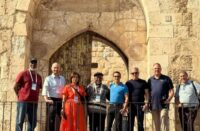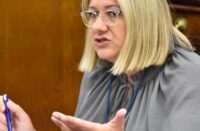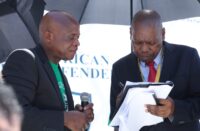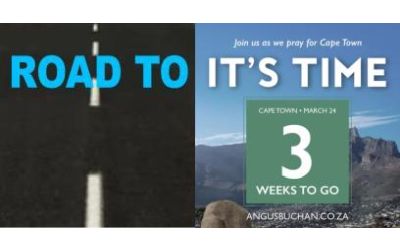
Ashley Cloete continues with part two of the Road to It’s Time series — a sweeping journey through the spiritual history of the Cape leading up to the It’s Time prayer day in Mitchell’s Plain Cape Town on March 24.
Episode 2: The Cape as a battleground of religious forces
Last week I suggested that the It’s Time Cape Town prayer day on March 24 could be part of a spiritual climax that has been building up for centuries in a spiritual battle centered around God’s redemptive purpose for Cape Town. Colonisers from Christian-influenced Europe, the indigenous Khoi people and Islamic prisoners from the East — and their descendants and later arrivals — all featured in an ongoing clash of religious and political ideologies — sometimes helping and sometimes hindering God’s greater purpose. We pick up on the spiritual battle again this week — and meet some spiritual giants who helped God’s cause and examine a clash between Christianity and Islam that took root in the Cape.
Repressive denominationalism
Stepping back into the 17th Century, we take note of a spiritually-influential agreement that was reached after the 30 Years War, which ended in Europe in 1648, which implied that colonial powers could enforce their national religion on the areas that they had geographically annexed and colonised. The Dutch won the initial race for the Cape when Jan van Riebeeck landed at Three Anchor Bay on April 6 1652. As a result of this no other churches except the Dutch Reformed denomination were allowed to operate in the area.
GROUND ZERO PRAYER STRATEGY
Jericho Walls International Prayer Network invites the whole of South Africa to join hands with Cape Town over 40 days as they prepare physically and spiritually for the very significant It’s Time prayer event — to cry out to God for Cape Town and the nation
The Cape would change hands in colonial terms from the British in 1795, to the French via the Batavian Freemason Rulers from 1803 to 1806. Brittania ruled the waves at the Cape for a second time in 1806. Denominational divisions, language and race issues would however curb spiritual progress from the very early years of the Cape Colony. Protestant missionaries were expediently abused to oppose Roman Catholicism in different parts of the world.
One of the worst examples of denominational discrimination worldwide was practiced at the Cape in respect of Catholics. Three Catholic priests, the first of whom arrived in October 1805, were requested to leave the Cape at the British re-conquest of the colony. The Freemason Batavian rulers prohibited teaching to slaves and the governor Caledon wanted missionaries to operate far away from the Cape. Governor Lord Charles Somerset attempted to counter the effect of the Dutch by bringing in Scottish Presbyterian ministers.
Other religions were even worse off. Muslims were merely tolerated and Judaism was trampled upon. The Dutch Reformed Church saw itself as the new Israel that replaced the Jewish nation. The erroneous notion of the replacement of Israel by the Church had been around for a long time although Paul had already taught in New Testament times that Gentile Christians have been merely grafted into the true olive tree Israel. The replacement theory had started already with the Samaritan Simon, the biblical opposite of Peter in Acts (according to oral tradition the magician that came to be known as Simon Magus was of Samaritan descent) and 2nd century Church father Justin Martyr. Martyr’s resentment towards Jews can be seen in his Dialogue with Trypho. Bishop Ignatius was another early Church father who taught replacement theology.
The French Huguenots, who arrived at the Cape after 1688, were spiritual relatives of the ruling church as Protestants, but even they were not allowed to use their language for worship. (In France the Huguenots had been persecuted by Catholics.)
Battle against Islam
In the coming weeks we will be looking at how Islam has been instrumental in curbing revival influences.
A mere six years after the Dutch settled at the Cape the battle against Islam began to take shape. The first Muslims to arrive were called Mardyckers (derived from the Indonesian word mardycka that denotes free people.), indicating that they were free people, i.e. not slaves. Even before they left their home soil in Indonesia, many of them had turned to Islam in solidarity with their fellow Ambonese — in opposition to the oppressive Reformed (Dutch) colonisers. As part of Dutch colonial policy their religious practices and activities were severely restricted. The threat of a death sentence hung over their heads if they tried to convert anybody to Islam.
The Dutch East India (trade) Company — backed by their rulers in Holland — fought Islam in the East with military means. When rebellious Muslim religious leaders offered stiff resistance in the Indonesian archipelago, the developing refreshment post at the Southern tip of Africa provided a handy place for the banishment of political convicts. The first religious prisoners came with a batch of slaves from the East that arrived on the Polsbroek from Batavia on May 13 1668.
The cold, nominal, Dutch Reformed brand of Christianity was no match in the battle for the hearts of the many slaves who were still open to the gospel. The spiritually-dead church had no credible message. In fact — as in Europe – a belief in magic and witchcraft still existed at the beginning of the 18th century. The Dutch fought a double fight in the East. The religious leaders opposing colonialism were Muslims. The Cape would be a convenient place to get rid of rebels.
Shaykh Yusuf, an Islamic Sufi resistance leader, came to the Cape on the Voetboog in 1694. He was interned with his 49 followers on the farm Zandvliet that belonged to Petrus Kalden, the Dutch Reformed dominee (minister) of the Groote Kerk. Despite his confinement he was credited with establishing Islam at the southern tip of Africa.
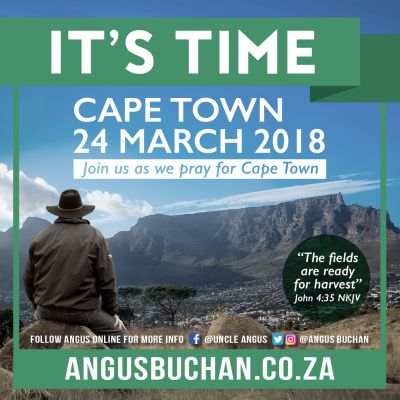
[fbvideo link=”https://www.facebook.com/UncleAngus/videos/10156324068573856/” width=”400″ height=”380″ onlyvideo=”1″]
Georg Schmidt, the first South African Missionary
In last week’s episode of this series I described Leendert Janssen and Nicolaas Proot as the first “activists” fighting for the human dignity of the Khoi. Just under a century later, the next significant initiative on that score was that of the German missionary Georg Schmidt who arrived at the Cape in July 1737.
His attitude towards people with darker skin pigmentation was very different to that of other Cape colonists. The prayerful Schmidt was the first missionary in South Africa. Before coming to our shores he had been imprisoned for his beliefs in the same area where Comenius had been persecuted. He was scoffed at by the colonists of the Cape for trying to reach out to the “Wilden”, the indigenous Khoikhoi, who they disparagingly called Hottentotten.
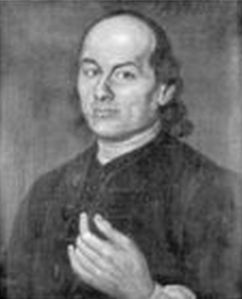
Schmidt refused to be sidetracked by conversions among the colonists, preferring to go to those who had not heard the gospel at all. After receiving a written ordination from Count Zinzendorf, the Moravian leader in Germany, he baptised his first five converts in a river in 1742. Those baptised included an intelligent Khoikhoi woman, Vehettge Tikkuie, who he named Magdalena at her baptism, albeit that he first had to overcome his prejudice against females. In no time Magdalena learned to read Dutch.
The Groote Kerk clergy applied so much pressure after Schmidt baptised Khoi that he felt compelled to leave for Europe. Schmidt hoped to get a Dutch Reformed ordination in Holland, which would have enabled him to return to the small flock he had to leave behind in the Overberg. But that was not to be. He did leave a New Testament with them from which Magdalena would minister among her people.
Schmidt continued to pray for his Khoi flock without a shepherd in Africa until his death in August 1785. At about the same time, Africo, one of his three male converts, passed on peacefully back in the Cape.
An Islamic response
In 1744, the same year in which Schmidt left the Cape for Europe, Tuan Said (his real name was Said Aloewie of Mocca in Yemen) was brought to the Cape. Said was listed as a “Mohammedaanse priester’”who had been sentenced to life imprisonment in chains. He served a sentence of 11 years on Robben Island before being brought to Cape Town where he became a policeman. It was this job that allowed him to visit the slave quarters to promote Islam. Along with the other imams, he apparently effectively countered the influence of South Africa’s first missionary.
When the sentences of the religious and other convicts who had been banished to the Cape expired, a few of them returned to Indonesia. But the majority stayed on. These ex-convicts formed part of the community of “Vrijezwarten” (free Blacks). They were the people – next to the religious convicts – who were greatly responsible for the consolidation of Islam at the Cape of Good Hope. Together with other slaves they met in homes for Islamic prayer meetings. Several of them possessed property and were financially independent and formed a small Muslim clerical class.
Christian slaves not to be sold
Many of the colonists actively encouraged slaves to become Muslims as a direct result of a “placaat” (decree), which prohibited the sale of Christian slaves. The slave owners at the Cape interpreted the decree as a threat, believing that their slaves would become free if they were baptised. On top of it, Muslim slaves could be entrusted to the wine cellars on religious grounds — a bonus in trade terms.
A Revival trailblazer
Meanwhile, Magdalena (the woman baptised by Georg Schmidt) became possibly the first female church planter worldwide. The seed that Schmidt had sown at the Cape during his stint of not-even seven years germinated, both in the Mother City and in Baviaanskloof — the later Genadendal. Schmidt was said to have been “a man of strong faith and a prayer warrior”. Apparently this example rubbed off on Magdalena. Khoi Christians reported that she was often found on her knees in prayer. On top of this she taught the believers from the New Testament which she had received from Schmidt.
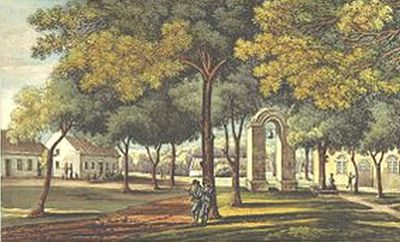
When three new missionaries — Christian Kühnel, Hendrik Marsveld and Daniel Schwinn — arrived at Christmas 1792, Magdalena had gathered a small fellowship of Khoi believers under the pear tree that had been planted by Schmidt.
The very first-known proper Cape revival occurred at the Moravian mission station in Baviaanskloof (that was later renamed Genadendal) soon after the arrival of the three missionaries. This was clearly supernatural — a result of the prayer chain in Saxony’s Herrnhut — 24 hours a day seven days a week — in East Germany that started in 1728. In the diaries of these three missionaries one reads again and again of Khoi coming to them, desiring to know more, wanting to accept the Lord into their lives and wishing to be baptised. Evidently the Holy Spirit had prepared these people. On a daily basis the Genadendal missionaries were overwhelmed by questions such as “What must I do to be saved?” It is striking that those who came to faith in Christ also sought protection against satanic forces.
Another spiritual giant
The fairly unknown Dr Helperus Ritzema van Lier, a Dutch Reformed minister of the Groote Kerk, has influenced mission history worldwide in a much bigger way than is generally recognised.
Officially Van Lier was appointed as the third minister (also in rank) of the Groote Kerk in 1786, i.e. a year after the death of Schmidt. Prior to his arrival in the Cape he had been deeply impacted by the evangelical revival which started in England under John Wesley, and then swept into the Netherlands, Germany and Scandinavia.
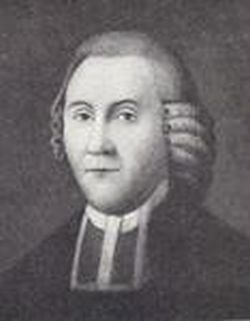
Very much ahead of his time, Van Lier opposed slavery in a low-key way and fought for the dignity of the indigenous Khoi while he attempted to learn their language. He found fertile ground among a group of believers at the Cape, including a group of pious Lutherans. They were the spiritual descendants of those believers who had been impacted by the short stint of Schmidt, 50 years earlier. Quite soon after Van Lier’s arrival at the Cape, the legacy of Schmidt in Baviaanskloof at the Sergeant’s River worked through into Van Lier’s life when he was present at the deathbed of one of the missionary pioneer’s converts. He had seen how the Khoi believer died “in volkome rus en vrede van sy siel en in vertroue op die Here.”1]
Local influence of the prayerful Van Lier
As early as 1788 various people in Cape Town and surroundings set aside one day a week for the religious teaching of “the heathen”. The church members met on certain days of the week for prayer and mutual edification, also giving religious teaching to the slaves and Khoi in their service. A local newspaper wrote at this time “When people were still discussing in many parts of Europe whether slaves and heathen should believe and whether they could be taught, they had already started with that work in this Colony.”2]
Van Lier did important spadework for what later became known as the South African Mission Society (SAMS). The Lord used him to bring about an “omwenteling” (revolution) in the attitude of many “White” believers towards slaves and other people of colour. The prejudice against missionaries was still prevalent when Van Lier arrived, but the youthful minister dared to challenge the Cape Christians through his fiery sermons and personal example.
The historian Theal reports that when the young dominee was preaching, people hardly dared to sleep in church because “at times it seemed as if he would jump from the pulpit”. Furthermore, his preaching was full of earnest appeals and “…women were often moved to tears, and sometimes fell into hysterics”.
Revival and spiritual warfare
A missionary prayer circle of about 60 people got off the ground around the above-mentioned evangelical group. They committed themselves in an organised way to weekly prayer (later twice a week) for the outreach to the “heathen” and the slaves.
Van Lier continued to lobby for missionary action, pleading for the establishment of a Dutch missionary society, for the admission of missionaries to the colony and urging the Moravians to re-enter the field. According to him, three enterprises were called for: “One among the Hottentots in the Colony, one among the Bantu in the East, and one among the indigenous peoples to the North”.
Next week we will read how Dr van Lier and a few other Cape church leaders would make a global impact. We will also challenge a gloomy outlook being spread around the world that says South Africa is heading the way of Zimbabwe under Robert Mugabe and towards major racial confrontation, in the wake of recent developments in our parliament. We dispute that view, and suggest that It’s Time Cape Town on March 24 will positively impact South Africa — and perhaps even the world. We will expound on that next week.


